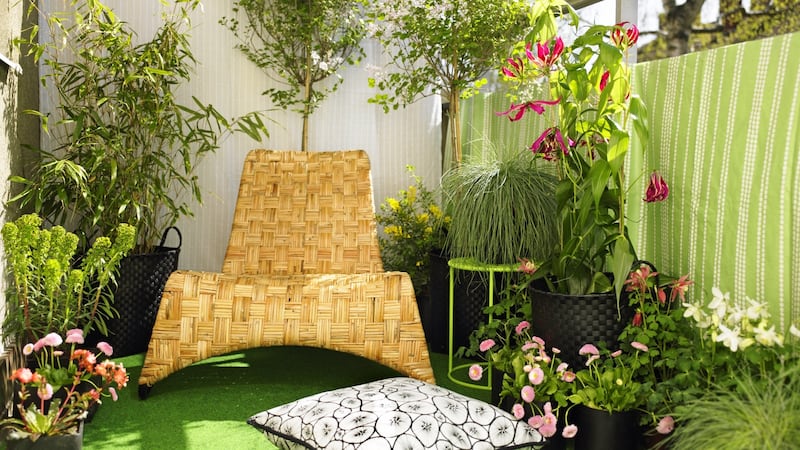Planning to start planting up your summer pots? Here are 10 useful tips to help you create a beautiful, long-lasting display of seasonal colour that will keep going until late autumn…
1 Avoid bargain trays of starved, wilting, pot-bound bedding plants that have been poorly cared for; these will always struggle to catch up and indeed some never will. Instead look for plants with healthy, plump, fresh foliage and without lots of faded flowers or yellowing leaves. For this reason it's always best to buy from a reputable garden centre or specialist nursery whose plants are properly cared for by knowledgeable, trained staff.
2 Less is more: The very best colour combinations are almost always a result of choosing and sticking to a particular palette rather than a random mishmash. This could be a vivid mix of brilliant oranges, hot pinks and glowing magentas, for example, or a soft and calming blend of gentle pastels, or a monochromatic display using different shades, tints and hues of one colour.
3 Flowers are important but foliage is key: Don't forget the importance of incorporating some handsome foliage plants into your container displays to serve as a long-lasting elegant foil to more ephemeral flowers. Silver leaved plants are particularly versatile in this regard and will work well with most colour combinations. Examples include the highly architectural Senecio candicans 'Angel Wings', felty-leaved Plectranthus argentatus, trailing Dichondra 'Silver Falls', Helichrysum petiolare and the ever-popular Senecia cineraria 'Silver Dust'. On the other hand, if vivid colour is your thing, then coleus is a great choice with a vast range of varieties available with foliage in fruity shades of zingy orange, lime, lemon and raspberry-pink. Or seek out Iresine herbstii Brilliaintissimum, whose beetroot-red trailing foliage also packs a serious visual punch. Another alternative is to use certain varieties of fast-growing leafy vegetables with colourful foliage including rainbow chard and Russian kale as well as Kale 'Midnight Ice' and Kale 'Emerald Ice' (available as seed from kingsseeds.com).
4 The right plant for the right place: The majority of traditional, short-lived summer bedding plants including varieties of cosmos, pelargonium, petunia, surfinia, diascia, argyranthemum, brachyscome and nemesia are sun-lovers that need a warm, sheltered spot to perform well. If all you can offer is a spot in light shade, then instead use varieties of shade-tolerant summer-flowering annuals such as nasturtiums (tropaeolum), tobacco plant (nicotiana) , bizzy lizzie (impatiens) and begonias.
5 Experiment: Don't be afraid to create container displays that combine summer-flowering bedding annuals with longer-lived shrubs and perennials; the latter can always be moved to a more permanent position in the garden once they've outgrown their temporary containers. Examples include ferns, hostas, trailing ivy, hydrangeas, Japanese acers, heuchera, box, the architectural Fatsia 'Spider's Web' and even some perennial geraniums including the long-flowering Geranium nodosum, all of which are also perfect for a shady spot. For a sunny position, consider lavender, Mexican fleabane (Erigeron karvinskianus), astelia, artemisia, penstemon, and long-flowering varieties of perennial geranium such as 'G Ann Folkard' and 'G Rozanne'.
6 Take some tips from Wicklow gardener and artist TJ Maher of Patthana Gardens in Kiltegan, who is known for his exuberantly colourful but painterly summer displays and who emphasises the importance of considering the design, colour and style of the containers themselves. In particular, Maher works on the principle that any display of summer containers looks best when the pots themselves are of similar shape and material. He also prefers to plant each pot with a single species/ variety rather than a mix, which allows him to easily rearrange these as different individual elements within the overall display throughout the summer for maximum impact and variety. These containers don't have to cost a fortune; cheap terracotta pots can be given a quick and easy makeover by painting them with a diluted water-based paint or greenhouse shading paint while household items (galvanized dust-bins, old metal water tanks, troughs) can also be creatively upcycled.

7 For a colourful and edible summer display, any of the following have pretty and edible flowers that can be used in salads, cakes, to flavour drinks and/or as garnishes: pot marigolds (Calendula officnalis), dill, amaranthus (Amaranthus caudatus), nasturtiums, dahlias, cornflowers (Centaurea cyanus), chives and day lilies (hemerocallis).
8 For maximum impact, stage your display of summer pots by placing them on upturned containers/ plinths/ small boxes so that they're at varying heights (think of it like the seating in an auditorium or stadium). To give extra height and visual impact, you could also use some fast-growing annual climbers which can either be bought as young plants or raised from seed sown within the next few weeks. Examples include sweet pea, morning glory (Ipomaea), canary creeper (Tropaeolum pergrinum), black-eyed Susan (Thunbergia), purple bell vine and Chilean glory vine (Eccremocarpus scaber). Stockists include all good garden centres and chilternseeds.co.uk.
9 To guarantee a long-lasting display until the first hard frosts, make sure to include some very floriferous, late-summer / autumn flowering varieties. Examples include varieties of French marigolds (tagetes), dahlias, salvias, cosmos and rudbeckia.
10 Gardening essentials: Don't skimp on quality when it comes to using a good, fresh, loam-based, multipurpose compost for your summer containers. It's also a good idea to integrate a handful of slow-release, pelleted organic fertiliser into the compost before planting to keep plants well-fed throughout the summer and early autumn. Gently soak the plants' root-balls in water for a few minutes before planting and make sure to regularly water containers throughout the growing season – get into the habit of doing the finger test regularly to check if the compost is too damp or dry. Once plants are in active growth, give them weekly liquid seaweed foliar feeds to boost healthy growth and to help to protect against pests and diseases. Lastly, take careful precautions against slugs and snails, especially when plants are young, and don't forget to deadhead faded flowers very regularly to keep those blooms coming.
















